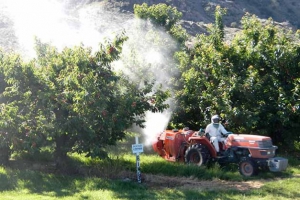
Brandon Mulvaney from Washington Tree Fruit Research Commission applies a spray application for the cherry residue trial in 2012 in a Bing block in Douglas County, Wash.
Courtesy Tory Schmidt/Washington Tree Fruit Research Commission
A study of pesticide residues on cherries at harvest showed that all were within the U.S. legal tolerances.
The Washington Tree Fruit Research Commission conducted the study, for the third consecutive year, to simulate the worst-case scenario for residues of legally applied pesticides. Sixteen insecticides/acaracides and ten fungicides were applied at maximum rates and minimum preharvest and retreatment intervals in a mature Bing orchard near Orondo, Washington. The products were applied with and without the protective rain coatings RainGard and Parka.
The aim of the study is to help Pacific Northwest cherry growers and consultants make more informed pest management decisions.
Although residues were comfortably within U.S. tolerances, some exceeded the maximum residue levels for certain export markets. Residues tended to be higher when either of the protective rain coatings were applied.
“There are some markets that have very low tolerances that growers need to be aware of,” reported Tory Schmidt, research associate with the commission. “Especially if they’re using rain protectants, they have the potential to have higher residues than they would normally.”
View the full results here or go to the Research Commission’s Web site to see results of the 2011, 2012, and 2013 studies.

Leave A Comment